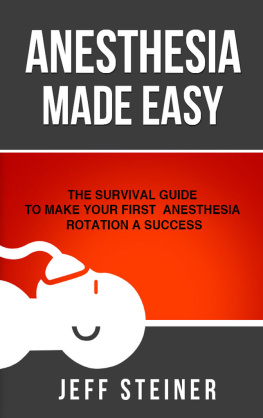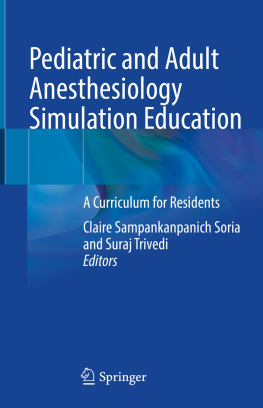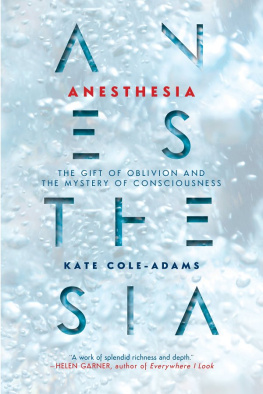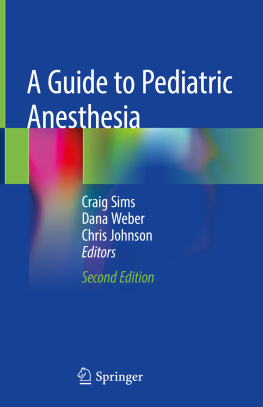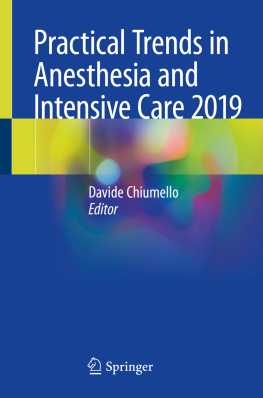Anesthesia Made Easy:The Survival Guide to Make Your First Anesthesia Rotation a Success No part of this publication may be reproduced, distributed, or transmitted in any form or by any means, including photocopying, recording, or other electronic or mechanical methods, or stored in any database retrieval system, except as permitted under Sections 107 or 108 of the U.S. Copyright Act and except for the use of brief quotations in book reviews, without prior written permission of the publisher. For permission requests, write to the publisher at the address below. 2015 Two Pugs Publishing
All rights reserved.
ISBN: 978-0-9898401-3-2
eISBN: 978-0-9898401-4-9 Material in this book is for educational purposes only and does not constitute medical advice or create a doctor-patient relationship. The book and the website AnesthesiaMadeEasy.com are intended for medical professionals and students who have formal education in general medicine and have or are in the process of learning the skills necessary to take care of patients during the perioperative period, while under the guidance of a licensed professional experienced in the practice of anesthesiology. Knowledge and best practices in the field of anesthesiology are constantly changing.
As new information is gained through research and clinical experience, it may be appropriate to change treatment and medication therapy. Readers are urged to check the most current information provided in the field of medicine and to review manufacturer information to verify the recommended dose, method and duration of administration, warnings, precautions and contraindications for medications and procedures presented. Some drugs and devices discussed in this book have limited or restricted FDA (Food and Drug Administration) clearance. It is the responsibility of the reader to ascertain the FDA status of each drug or device for use in a clinical setting. This book is intended as an overview and guide, and is in no means exhaustive in its scope. It is the responsibility of the practitioner to determine dosages and best practices for each patient based on his or her experience and the circumstances of patient treatment.
Ultimately, the administration of anesthesia and care of the patient rests on the practitioner. Care has been taken to confirm that the information presented is correct and is in line with generally accepted practices. That being said, the author, editors, contributors, and publisher are not responsible for errors or omissions of information or for any direct or indirect consequences of the application of information in this book and website AnesthesiaMadeEasy.com. Neither the author, editors, contributors, nor the publisher make any warranty, express or implied, or assume any liability for injury and/or damage to persons or property arising out of or related to any use of the material contained in this book. Why you need Anesthesia Made Easy. Most introductory anesthesia books are too long and too complex.
Where do you begin learning about anesthesia when the basic books are over 800 pages long and weigh four pounds? Even when you do read these books, how will you translate the information into something you can use in the operating room when you are first starting out? Welcome to Anesthesia Made Easy. I wrote this book to introduce you to anesthesiology. It is part education guide (to teach you the basics of anesthesia) and part survival guide (to teach you how to apply these basics while in the operating room). It includes the basics of anesthesia without getting too far into the weeds and also gives you a practical approach that will get you started moving in the right direction. When I was chief resident at UT Southwestern Medical Center, I developed a new system on how to train new anesthesia residents titled Vapor Camp. It is a revolutionary way to give interns exposure to the operating room, anesthesia didactics, and simulation scenarios before they are expected to perform on their own.
Now, as Vapor Camp approaches its seventh year, I have realized that the program needs a manual: Anesthesia Made Easy.
Currently, I train airway rotators, anesthesiologist assistant students, medical students, residents, and fellows in the art and science of anesthesiology through lectures and in the OR. New anesthesiology students struggle with which book to read and where to start. This book will give you not only a solid foundation upon which to start your career but also organize the information in such a way that you can actually use it. If you are doing anesthesia observations or shadowing to see if anesthesia is a good fit for you, you should start with to learn the culture of the ORthey will bring you a long way. If you are an airway rotator, concentrate on If you are on your first anesthesia rotation, start at the front of Anesthesia Made Easy and work your way through before you start your rotation. This book is meant to be a quick read.
Bring the book with you to the operating room and take notes in the notes section. Then when you go home, pull out one of the basic books listed in and read up on the topics that you want more information on. If you are an anesthesia tech or working toward your anesthesia technologist certification, this book will give you an introduction to the art and science of anesthesiology. It should give you an overview of what anesthesia is like and should help you see the specialty from a different viewpoint. Start at the front and work your way through to the end. Ask questions and take notes to help you be better at your job.
As you prepare for your exam, I have listed some resources for you at AnesthesiaMadeEasy.com. If you are applying to AA or CRNA school, then read this book cover to cover before you interview. It will give you a working knowledge of the type of training you will receive. It may also help you in your interview process to give you answers to simple questions about anesthesia care. If you are medical school student applying to an anesthesiology residency, check out my website, AnesthesiaMadeEasy.com, which offers a free e-book, Getting into Anesthesiology, to help guide you through the application process. This is my interpretation of the art and science of anesthesiology as I know it.
There are many different ways to safely care for patients under anesthesia. This book is just to get you pointed in the right direction. Anesthesiology Made Easy should be your jumping off point; this book will teach you a lot of the how, but you will likely need to read other books to learn more of the why as you go through your training. I wish you well as you start your career in anesthesiology. Jeff Steiner, DO, MBA Acknowledgments I want to extend a heartfelt thank you to all my beta readers (listed in alphabetical order below). Without your assistance, I would have published several mistakes, and a few faux pas.
Ty Carl, BS Eugene Chung, DO Jana McAlister, MS, MMSc, AA-C Ryan A Sexton, RN, MSN, CRNA Jennifer C. Steiner, PA-C Peter Szmuk, MD Amy P. Woods, MD I also want to thank my online team that helped me bring this project to a new level. Book Cover Design by Daryl Orosco at Designers-Pro through 99desgins.com. Professional Editing Services by Karen Otis through ProofreadingPal.com. . 1. 1.
Getting the Most from Your Anesthesiology Observation A career in anesthesia is not for everyone. Observing anesthesia the first time can be overwhelming. There are many moving parts in the operating room and several transitions that patients go through. The anesthesia team is responsible for not only the operative period (while in the OR) but also the preoperative care (to make sure the patient is ready for surgery) and postoperative care (to make sure the patient successfully transitions from the OR to the postanesthesia care unit [PACU] or intensive care unit [ICU]). Along with taking care of patients, there are also time constraints placed on the whole OR team. You will see different members of the anesthesia and OR teams working together to bring the patient safely through the perioperative period.
Next page
